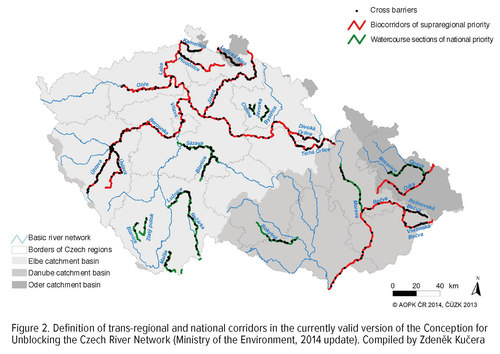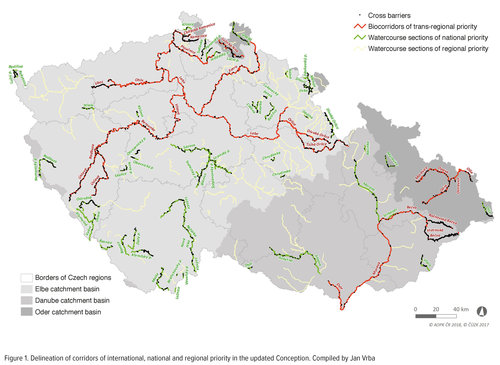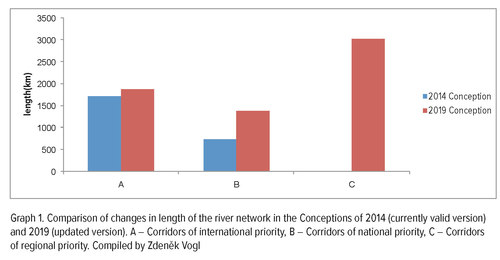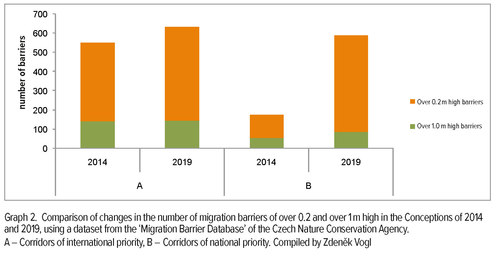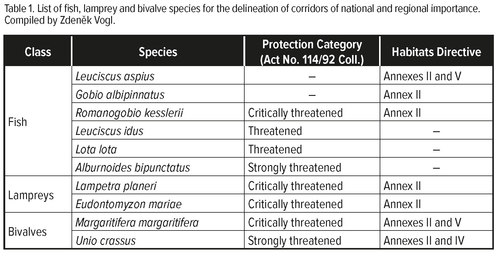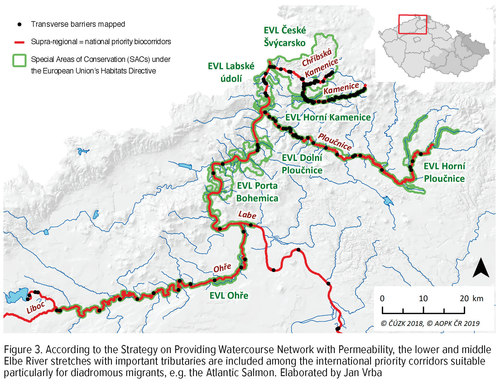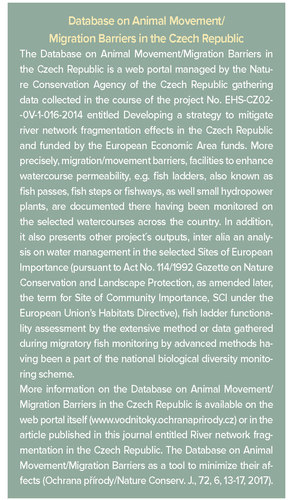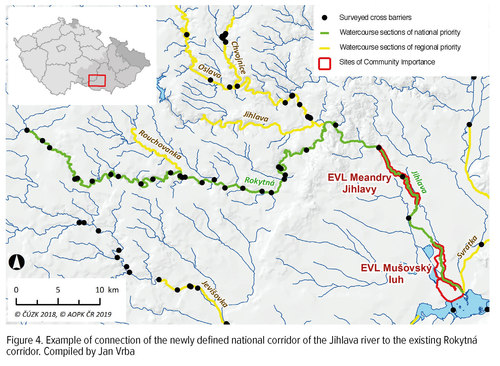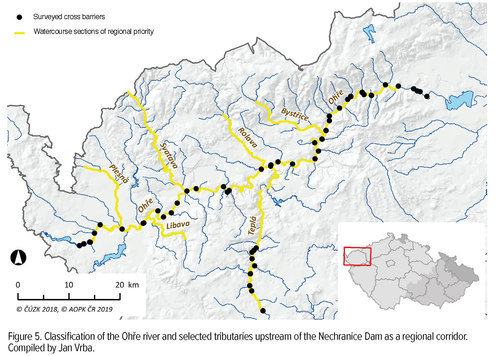Nature Conservation 2020 — 25. 3. 2020 — Nature and Landscape Management — Print article in pdf
Update of the Conception for Unblocking the Czech River Network
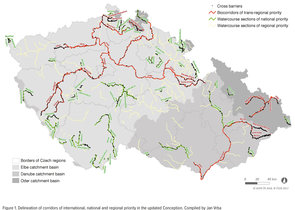
This year, already a second update of the Conception for Unblocking the Czech River Network, an important water management planning document, will be completed. At present, the Czech Nature Conservation Agency is working on a proposal delineating watercourses which are primarily determined to be made passable for migration, at the same time respecting territorial and species protection.
For this reason, the length of corridors will generally increase as compared to the present situation. These will be prioritised in the subsidy policy also in future. The objective of the updated version of the document is to implement measures providing free migration to fish and other water animals in an effective and systematic way, especially on watercourses of international and national importance.
Current Conception
The Conception is a strategic document of the Ministry of the Environment, aimed at setting priorities which establish options for bidirectional migration of water organisms on Czech watercourses by opening cross barriers. Particularly longitudinal continuity of watercourses is one of the requirements to achieve a good ecological state of a waterbody according to the ‘Water Framework Directive’ (2000/60/ES) implemented in the ‘Water Act’ (as amended). It is being realised thanks to, among others, a water planning process.
In the presently valid Conception, watercourses of international (Category A) and national (Category B) importance are defined (see Fig. 2). The first ones are formed by corridors linked to marine environments intended for diadromous fish migration, in our conditions particularly eel (Anguilla anguilla) and salmon (Salmo salar). The other ones have been defined according to priorities in territorial and species protection, primarily with regard to threatened bivalve species.
Why is the Conception being updated again?
Before each stage in water management planning, it is necessary to revise all relevant documents, add current knowledge and update them with newly available data. Besides a selection of priority watercourses, especially for distant migrants, the updated version of the Conception takes territorial and species protection based on national and European legislation into account in a comprehensive way (see Fig. 1). For these reasons, nearly a doubling of national corridors and definition of a completely new category, Category C, for watercourses (or sections of them) of regional importance have been achieved. A numeric comparison of changes in the currently valid and updated version of the Conception is illustrated in Graphs 1 and 2.
Trans-regional International? corridors were originally selected with regard to their high ecological potential, absence of water reservoirs and the abovementioned link to marine environments. The location of lake systems across these watercourses and the excessive number of migration barriers were omitted. The update aims at taking these factors into account. In Category A, the most significant changes have been made in the Oder catchment basin, particularly given the historical occurrence of salmon. In order to return this species, the Opava river – in connection to the Moravice river – was delineated up to the water reservoir at Podhradí. In the Elbe catchment basin, moreover, the Chřibská Kamenice river was included up to the village of Chřibská and in the Ohře (Eger) catchment basin, Liboc was included for this flag species. In both these watercourses, salmon is repatriated by the Czech Anglers Union as part of the long-term programme Losos 2000. To preserve migration permeability, also the Dyje (Thaya) river from its confluence with the Morava river to Nové Mlýny waterworks was included in this category. On the other hand, some river sections were shortened, e.g. the currently delineated Ploučnice river (from its confluence with the Elbe to its confluence with the Ještědský potok stream) and the Oder (from the state border to the SW boundary of Poodří Protected Landscape Area). This category may be reduced in the negotiations to be followed by excluding the upper sections of the Rožnovská Bečva and Vsetínská Bečva streams as a result of the relatively high number of cross barriers.
Category B includes watercourses or sections of them inhabited by protected animals or animals of European importance with a high migration demand of the species themselves or of species existentially dependent on these migrants (a list of species is given in Tab. 1). These species are always the protection target of an SCI or nature reserve. Category B watercourses are often short, isolated sections which have been included for the mosaic location of protected areas. An example is the Račinka stream, where Ukrainian brook lamprey (Eudontomyzon mariae) is the reason for protection. For European brook lamprey (Lampetra planeri), watercourses on the territory of e.g. SCI Olše, SCI Moravice and SCI Údolí Chrudimky have been included. The river Vlára in the Bílé Karpaty (White Carpathians) Protected Landscape Area is included for the occurrence of chub (Alburnoides bipunctatus) and provides at the same time protection to other fish species, particularly the loach Sabanejewia balcanica. For pearly mussel Margaritifera margaritifera, e.g. Lužní potok stream in the Aš region has newly been included. In some cases, links to currently defined corridors have successfully been made. For example, the Jihlava river, upstream of the Nové Mlýny reservoirs, is connected to the presently defined Rokytna, intersecting SCI Mušovský luh and SCI Meandry Jihlavy, protected for the occurrence of white-finned gudgeon (Romanogobio albipinnatus) (see Fig. 3).
The regional corridors have been defined by staff of the regional offices of the Nature Conservation Agency or national park authorities based on certain criteria according to a uniform methodology displayed on www.vodnitoky.ochranaprirody.cz.
For classification into this category, in contrast to national corridors, only species protection has been taken into account. Other criteria were number of migration barriers, hydromorphological and ecological quality of waterbodies, and connection to corridors of higher priority. This category includes among others the Ohře river with notable tributaries upstream of the Nechranice Dam, which prevents inclusion of the entire watercourse into the category of corridors of international priority (Fig. 4). In the areas concerned, also the occurrence of invasive crayfish species has been taken into account in order to prevent spread of the crayfish plague. For these reasons, the Conception does not include e.g. the Stroupinský potok stream in the Křivoklátsko Protected Landscape Area, where our native crayfish was affected by this fungal disease last year.
Financing of the proposed measures
Watercourses delineated as mentioned above will be prioritised in the subsidy policy of the Ministry of the Environment, particularly in the Operational Programme Environment (up to 100% of the expenses). The allocation of finances is still considerable. We expect a substantial increase in submitted projects (or requests), with regard to the demanding preparation of the actual measures as well as to the administration involved in subsidy requests, from a few per year at present to at least dozens next year.
Conclusions and expectations of the updated Conception
The updated Conception should serve as a document for the third water management planning period, running from 2022 to 2027. Its objective is to comprehensively define watercourses significant from the perspective of nature and landscape conservation, primarily securing the continuity (migration permeability) of these watercourses, thus implementing, among others, the ‘Water Framework Directive’. This requires, besides securing migration permeability, also the preservation or restoration of other stream functions like the stream load regime and self-purification functions. In accordance with these objectives, appropriate adjustments of the measures should be chosen in the following order: (1) removal of cross barriers, (2) near-natural solutions such as boulder chutes, (3) fish ladders, optimally accompanied by revitalised watercourse sections linked to them, e.g. in the form of spawning grounds, distributaries, groynes, etc.
The document should further present the current measures and novelties in this particular field in a comprehensive way, including fundamental problems with solving migration permeability, especially on corridors of international and national priorities. The objective of updating the Conception is not only to delimit these corridors, but also to establish conditions to make them passable in a systematic and effective way.


